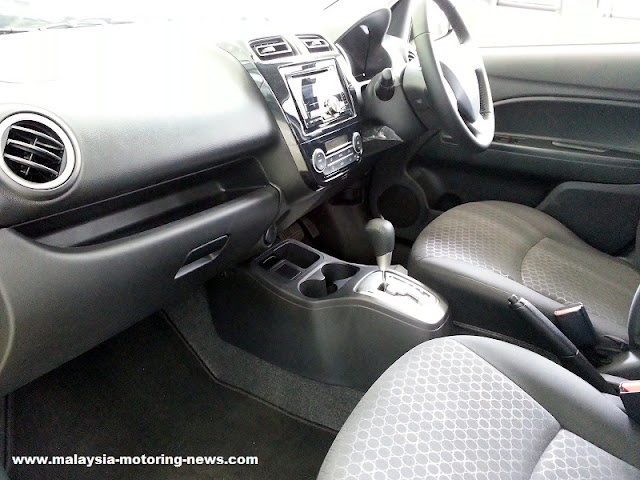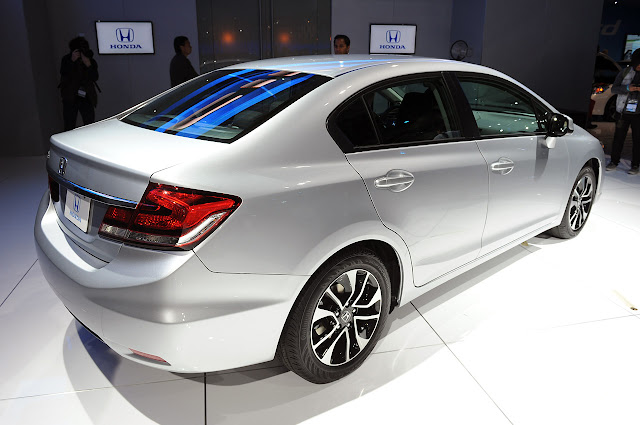Honda has debuted its heavily facelifted North American Civic at the Los Angeles Motor Show. The updated model received a total aesthetic makeover on the outside and inside, and the chassis setting has been recalibated, both intending to rectify the cheap-car feeling of the 2012 model and set to deliver a more satisfying driving experience.
From the outset, it is clear that the 2012 Honda Civic is the car for recession time. In order to fulfill the targeted projected area in side, front, rear and top elevation with minimum material achievable, all the surfaces has been flattened. Why? The curvier metal and plastic panels consume more raw material for a given projection area and the heavier the curve, the deeper the tooling (stamping or moulding) has to be. Hence, a flatter surface not only uses less material, but the tooling can be made smaller and cheaper too. So, there goes the wrap-around fender and sculpted dashboard of the Civic FD generation. While they were at that, all the expensive garnishing like the interior bezel has been taken away too.
This time around, Honda America has re-sculpted the entire front end by giving is a new hood, bumper and grille. The plain looking front end has been beefed up with more substantial bumper featuring the thick chrome bar too. The grille outline has been thickened, and chromed too ala the new Accord. The hood panel has been reprofiled and this lend a more voluptuous look.
The weedy rear end design has been totally ditched. From both photos above (credited to
Autoblog), the entire trunk lid is an newly designed item and it features an embedded tail light too. Mind you, it is not the half-hearted reflector insert like the Asian model, but a totally new jewel-like light assembly. Together with the chunkier rear bumper particularly at the lower portion, the rear end now has a more planted stance.

The upscaling move continues with the cabin design. The drab cabin of the 2012 car made way for the redesigned dashboard, floor console and door trim. For the centre console, the audio and aircond control panel has been re-specified with more premium design. The airvents has been resized and garnished with chrome surround. Similar treatment are given to the gear console where the gear base is trimmed in metal-look, and the gear slot is chrome-lined. Similar chrome line is inserted to the cup holder too, although it still lacks the sliding cover of the Asian car. The door trim has been revised, whereby the top portion has been totally redesigned, and now moulded with padded material like the Asian car. Subtle silver insert is there too to punch additional elegant touch. Both the dashboard and door trim top panel comes with leather-like stitching for an added opulence. Tricot headliner complete the interior makeover.
The improvement does not stop there. Honda has taken the opportunity to quicken the steering ratio, stiffen the anti roll bar and front spring while the front disc brake has been enlarged by 20mm to 282mm. All these measures to a better handling and braking performance.
Safety has been enhanced too. Debuting on 2013 Honda Civic are the SmartVent which is a device to minimise the excessive side airbag deployment force, curtain airbags and new alert system in the form of Lane Departure Warning and Forward Collision Warning systems.
Also making an inroad into the 2013 Civic is a host of multimedia experience found on the recently introduced Honda Accord. Among them are the Bluetooth Hands Free Link, rear view camera, colored i-MID, Pandora Interface and SMS functionality.
Lets get into the detail of the changed item and how does it fare with the outgoing 2012 car, and to certain extend we would like to draw some comparison with the Asian car. The new fascia really added the much needed premium touch to the Civic. The original American Civic bumper is a tad drab compared to the Asian version, which subtly comes with chunkier lower edge and hence looks sportier. Meshed grille insert also has replaced the previous horizontal bars item.
Majority of the change happen at the back. It is clear cut here that the more jewel-like rear light and tastefully applied chrome does bring the Civic outlook to a more premium level. The lower valence too lends some air of solidity to the rear end of the Civic, which can look under-substance on both outgoing American and current Asian car.
For the interior, apart from the redesign centre cluster, the re-defined gear console has certainly hit the mark. The current gear console, on any continent, can be best described as cheap looking. The black gear surround really belongs to the Honda City class instead of the Civic class. Honda has ditched the previous console, and income a wider gear base that is finished in the metal look (like Civic FD) and the gear gate has been chrome-lined. Honda Malaysia, can you find a way to incorporate this minor enhancement somehow in our Civic?

The Asian Honda Civic has been blessed with the soft touch material on the upper door trim section, while the 2012 American Civic did not come with this. For the 2013 enhancement, Honda did not simply take the Asian design and applied to the American Civic, it has gone the long route by redesigning the upper section. The padded upper section also come with the stitch-like finishing and the silver accent is a nice addition. The silver trim looks really integrated, unlike the after-though look like the Asian Civic.
The audio system also has not been spared in this round of extensive update. The jumbo-sized audio button with its plain design has been updated. The panel is now more contoured and glossy in finishing and there is also some chrome insert included too.
In North America, the new 2013 Honda Civic continues to come in the sedan and coupe guise. While the sedan has received all the detail update, the coupe make do with the new wheel design. Trim wise, the entry level DX trim has been dropped, thus now comprises of LX, EX, EX-L and Si. The first 3 trims are powered by the familiar 1.8L mill paired to either 5 speed manual or automatic transmission. The range-topper Si is powered by the 2.4L engine and paired only to the 6 speed manual gearbox. In between, there is also a natural gas version with 1.8L engine (110hp) while the Civic Hybrid is powered by the 1.5L gasoline hooked to the IMA system.
For all the improvement, the Civic range starts from $18,615 for the Sedan LX and stops at $26,465 for the Civic Natural Gas. Compared to the 2012 price, the price increase is mere $160.
What do you think about the enhanced Honda Civic? Are there any update you would like to have in the Malaysian version? More photos of the 2013 Honda Civic can be found after the jump.


































.jpg)
.jpg)









